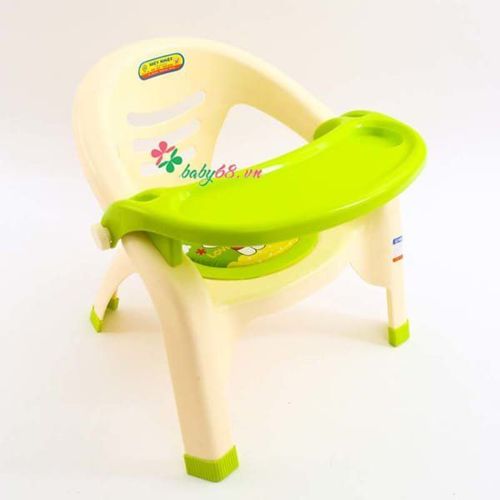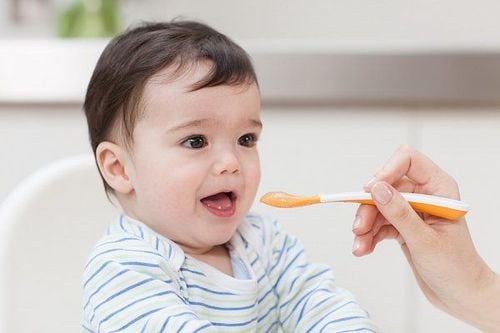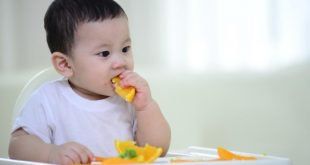This is an automatically translated article.
The article was consulted with Dr. Nguyen Thai Ngoc Chau - Neonatologist - Pediatrics - Neonatal Department - Vinmec Phu Quoc International General Hospital.Solid foods are a huge step forward for a baby, and learning when and how to make the transition from breast milk or formula to solid foods is something every caregiver needs to know.
The National Institute of Nutrition recommends that after 6 months is the best time for babies to start solid foods, and most babies are ready to start eating solid foods to supplement breastfeeding or formula feeding. During this time, infants usually stop using their tongue to push food out of their mouth and begin to develop the coordination ability to move solid food from the mouth to the back for swallowing.
1. Signs that your baby is ready for solid foods
Solid foods are the time when your baby transitions from eating exclusively breast milk or formula to eating a wider variety of foods. For children under 1 year of age, the main food is still breast milk and formula, but by the age of 6 months, the baby's body requires more nutrients from foods other than milk.In order to well meet the nutritional needs of the child's age as well as practice the milestones of skill development in each stage, mothers should introduce solid foods before the age of 1 so that the child can get used to food and enjoy it. interested in solid foods. The best time to introduce solid foods to your baby as recommended by the World Health Organization or the American Academy of Pediatrics (AAP) is when the baby is 6 months old, is completely healthy, and has the following signs: ready for solid foods:
Child can hold his head in a firm upright position Child can sit well on his own or sit firmly with little support Child shows appetite by leaning forward and opens mouth when given food by an adult Some children can grasp and put food correctly in their mouth Children showing signs of tongue thrusting to get food from the tip of the tongue into the throat American Academy of Pediatrics also It is recommended that infants continue to be fed breast milk or formula for as long as they are introduced to solid foods up to at least 12 months. You should continue breastfeeding after 12 months if the baby still needs it. Take your baby to the doctor to have their vitamin D and iron intake checked during the first year.
2. Preparations for eating solid food
Food preparation utensils for children should include: Pots, pans, sieving tools, food grinders...Weaning tools include: Weaning chairs, small bowls, small spoons, food trays, Bibs, cups to practice drinking water.... Among these weaning chairs are very important if you want your child to practice good eating habits and table discipline. Food for children should be prepared and processed with safe ingredients, if made from plastic should use BPA-free plastic. Utensils for processing raw and cooked foods should be clearly distinguished and not shared with the rest of the family. Highchairs should also be made of BPA-free plastic or wood and have no sharp edges to avoid hurting your baby.

Ghế ăn dặm rất quan trọng nếu bạn muốn cho con tập thói quen ăn uống tốt và kỉ luật bàn ăn
3. The journey of learning to eat solid food
3.1 A Simple Start The first day you introduce your baby to solid foods, you should offer your child single-ingredient foods that are free of sugar and salt. Start with a few spoons, feed your baby while talking to him about what you are doing. Babies may wrinkle their nose, gag or spit at first, which is completely normal.Another way to make the first weaning easier and not too hungry is to give your baby a little breast milk or formula and then give him a few spoons and finish with breast milk or formula milk. This will not make the child too upset because of hunger.
Get ready for your baby to put solid food on, utensils and bibs. Persist in feeding children gradually increase the amount of food each day so that the child can gradually get used to eating solid foods.
Do not force children to eat when they cry, gag or turn away from accepting food. Do not let the meal be a torture for the child, it will create a bad reaction later, the child turns away when he does not want to continue to eat and please respect that right of the child.
Always remember that eating solid foods is a gradual process, at this time babies are still getting nutrients from breast milk or formula, food for babies is just a new experience, and not Who wants that experience turns into a nightmare for children. In addition, each baby has completely different needs, so the level of readiness for solid foods is also different.
3.2. What foods to eat For most babies, it doesn't matter what solid foods are for the first time. Traditionally in the United States, cereals are often the first foods introduced. However, there is no medical evidence that giving solid foods to babies in any particular order is beneficial for them. Although many pediatricians will recommend starting vegetables before fruit, there's no research to prove that babies won't like vegetables if they're given fruit first. Babies or young children are born with a preference for sweets and the order of introduction does not change this. It is important when choosing foods for babies that clean foods are carefully prepared and provide enough iron and zinc to be absorbed more easily than needed for babies from 6 months old

Đối với hầu hết trẻ sơ sinh, thức ăn đặc cho lần đầu tiên là gì không quan trọng
Cooked and cooled vegetables like carrots, potatoes, sweet potatoes, pumpkin Cooked and cooled fruits like peaches, apples, pears ... Baby rice or cereal, mixed with milk daily the child is taking oranges, strawberries and mangoes. Once your child is interested in vegetables and fruits you can switch to foods from the following groups
Bread, rice, pasta Full-fat dairy foods like cheese Meat, fish, eggs , bean. Unsafe foods for babies
Honey can contain bacteria that can make babies under 12 months of age very sick Whole nuts because of the risk of choking, or allergies to families with a history of allergies response to peanut products Unhealthy fish such as shark and swordfish are high-mercury fish that are not safe for children. Foods high in salt or sugar: Too much salt (more than 1g per day) will be harmful to your child's kidneys. Sugar is harmful to children's teeth, avoid giving children sweets such as cakes, cookies, sugary drinks. Fresh milk

Sữa tươi không phải là thực phẩm an toàn cho trẻ ăn dặm
Offer your child a variety of foods including potentially allergenic foods like peanuts, eggs and fish. In fact, delaying the introduction of potentially allergenic foods has not been shown to prevent eczema, asthma, allergic rhinitis, and food allergies. Even introducing certain foods early, such as peanuts and eggs, can reduce the risk of an allergic reaction to that food.
However, if anyone in your family is allergic to the above foods, be careful when giving this food to your child. Within a few months of starting solids, your baby's daily diet should include a variety of foods, such as breast milk, formula, or both; kinds of meat; cereals; vegetable; fruit; egg; and fish.
3.4. Should children drink juice? Children younger than 12 months should not be given juice. Juice is not a necessary part of a child's diet and it is not as valuable as whole fruit. After 12 months - up to 3 years old, give only 100% fruit juice and no more than 120ml/day. Juice reduces the appetite for other, more nutritious foods, including breast milk, formula, or both. Too much juice can also cause diaper rash, diarrhea, or excessive weight gain.
3.5. Does the child need more water? Healthy babies do not need extra water, do not give them water until they are 6 months old to avoid the risk of water intoxication. Breast milk, formula, or both provide all the fluids a baby needs. However, with the introduction of solid foods, water can be added to the baby's diet. In addition, when the weather is too hot, children can drink a little more water.
3.6. Practice good eating habits early For enjoyable mealtimes, talk to your child when feeding, praise him when he eats well, or cooperate with you during meals. It is important when giving children to practice eating solid foods that children gradually get used to the food, sit down to eat, put a spoon in their mouth, rest between chewing and stop until they are full. These early experiences will help your child learn good eating habits throughout life. But also need to remember "table discipline" so that children have good eating habits in the future. Here are some suggestions
Sit in place: As soon as your baby is able to sit easily without support, use a high chair with a wide and firm base. Fasten seat belt.

Ngay sau khi em bé của bạn có thể ngồi dễ dàng mà không cần hỗ trợ, hãy sử dụng ghế ăn dặm có đế rộng và vững chắc. Thắt dây đai an toàn
For children to be healthy and develop well, it is necessary to have a nutritious diet in terms of quantity and quality balance. If children are not provided with adequate and balanced nutrients, it will lead to diseases of excess or lack of nutrients, which adversely affect the comprehensive development of children in terms of physical, mental and motor skills.
The period of baby eating solid foods is an extremely important period to help children develop comprehensively. Children who do not eat properly are at risk of micro-mineral deficiencies, causing anorexia, growth retardation, malabsorption, etc. If they notice the above signs, parents should supplement their children with supportive products. The supplement contains lysine, essential micro-minerals and vitamins such as zinc, chromium, selenium, and B vitamins to help fully meet the nutritional needs of children. At the same time, these essential vitamins also support digestion, enhance nutrient absorption, help improve anorexia, and help children eat well.
Parents can learn more:
Signs of zinc deficiency in children
Micronutrient deficiency and failure to gain weight in children
Please regularly visit Vinmec.com website and update useful information to take care of your child. Take care of the baby and the whole family.
References: mayoclinic.org, healthychildren.org, babycenter.com














